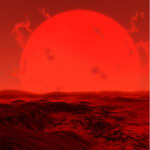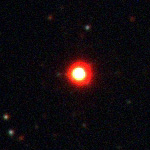|
Our Sun
|
Our Sun
 Ultraviolet image taken of the sun by a NASA solar imaging satellite.
Ultraviolet image taken of the sun by a NASA solar imaging satellite.
Sun from Earth orbit
 The sun as seen from the space shuttle in orbit around the Earth.
The sun as seen from the space shuttle in orbit around the Earth.
Sun Facts
- The sun is a star at the centre of our solar system and is thought to be around 4.5 billion years old.
- It has a diameter of around 865,000 miles (1.4 million km), which is 109 times larger than Earth.
- The mass of the sun accounts for 99.86% of all the mass in the solar system.
- Three quarters of the sun is composed of hydrogen with helium making up most of the rest.
- The sun is actually bigger and brighter than the vast majority of stars in our galaxy.
- Large explosions from the sun which are called flares produce solar winds in our solar system.
- Sunspots are cooler areas on the sun's surface as large as 50,000 miles (80,000 km) making them visible from Earth with the naked eye.
- The sun is actually white, the Earth's atmosphere makes it appear yellow.
- In around 5 billion years time the sun will become a red giant, destroying the Mercury, Venus and Earth in the process.
Orbit, Atmosphere & Temperature
 A large solar flare erupting from the sun.
A large solar flare erupting from the sun.
Orbit
The sun orbits around the centre of our galaxy, the milky way, at a distance of around 25 million light years taking about 250 million years to make one orbit.
Atmosphere
The atmosphere of the sun consists of several layers called the photosphere, chromosphere, transition region and corona. The photosphere is the lowest layer
and the visible surface of the sun we see. The corona is the outer layer which produces flares and solar winds.
Temperature
Temperatures at the photosphere are around 5,500C (10,000F). At the sun's core temperatures are over 15 million C (27 million F).
| Life of Our Sun |

| Our Nearest Neighbours |

| The Sun - Images and Video |
Solar eclipse


Sun Rotation (NASA)
Sun in our sky


|
The Sun - Vital Statistics
Comparison with Earth
|
Diameter: 864,000 miles (1.4 million km)
Distance from Centre of Galaxy: 25 million light years
Orbital Period: 250 million years
Rotation Period: 25.38 days
Maximium Temperatures: 15 million C (27 million F) (Core)
Minumum Temperatures: 5,500C (10,000F) (Photosphere)
Gravity: 274 m/s2 (28 x Earth's Gravity)
Density: 1.409 g/cm3 (25.5% Earth's Density)
Mass: 1.989 x 1030 kg (333,000 x Earth's Mass)
Volume: 1.412 x 1018 km3 (1.3 million x Earth's Volume)
Atmosphere (Photosphere): Hydrogen 73.46%, Helium 24.85%, Oxygen 0.77%, Carbon 0.29%, Iron 0.16%, Sulfur 0.12%, Neon 0.12%, Nitrogen 0.09%, Silicon 0.07%, Magnesium 0.05%.
Distance from Centre of Galaxy: 25 million light years
Orbital Period: 250 million years
Rotation Period: 25.38 days
Maximium Temperatures: 15 million C (27 million F) (Core)
Minumum Temperatures: 5,500C (10,000F) (Photosphere)
Gravity: 274 m/s2 (28 x Earth's Gravity)
Density: 1.409 g/cm3 (25.5% Earth's Density)
Mass: 1.989 x 1030 kg (333,000 x Earth's Mass)
Volume: 1.412 x 1018 km3 (1.3 million x Earth's Volume)
Atmosphere (Photosphere): Hydrogen 73.46%, Helium 24.85%, Oxygen 0.77%, Carbon 0.29%, Iron 0.16%, Sulfur 0.12%, Neon 0.12%, Nitrogen 0.09%, Silicon 0.07%, Magnesium 0.05%.
Diameter: 7,926 miles (12,756 km)
Average Distance from Sun: 93 million miles (150 million km)
Orbital Period: 365.24 days
Rotation Period: 23.934 hours
Maximium Surface Temperatures: 58C (136F)
Minumum Surface Temperatures: -88C (-126F)
Gravity: 9.766 m/s2
Density: 5.515 g/cm3
Mass: 5.9737 x 1024 kg
Volume: 1.0832 x 1012 km3
Atmosphere: 78.08% nitrogen, 20.95% oxygen, 0.93% argon, 0.038% carbon dioxide, water vapour makes up on average around 0.4% of Earth's atmosphere depending on climatic conditions.
Average Distance from Sun: 93 million miles (150 million km)
Orbital Period: 365.24 days
Rotation Period: 23.934 hours
Maximium Surface Temperatures: 58C (136F)
Minumum Surface Temperatures: -88C (-126F)
Gravity: 9.766 m/s2
Density: 5.515 g/cm3
Mass: 5.9737 x 1024 kg
Volume: 1.0832 x 1012 km3
Atmosphere: 78.08% nitrogen, 20.95% oxygen, 0.93% argon, 0.038% carbon dioxide, water vapour makes up on average around 0.4% of Earth's atmosphere depending on climatic conditions.
| The Sun Compared to Earth in Size |

| Sponsored Links |
